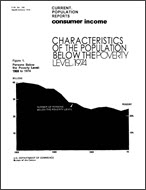
An official website of the United States government
Here’s how you know
Official websites use .gov
A .gov website belongs to an official government organization in the United States.
Secure .gov websites use HTTPS
A lock (
) or https:// means you’ve safely connected to the .gov website. Share sensitive information only on official, secure websites.
-
//
- Census.gov /
- Library /
- Publications /
- Characteristics of the Population Below the Poverty Level: 1974
Characteristics of the Population Below the Poverty Level: 1974
Characteristics of the Population Below the Poverty Level: 1974
This report presents detailed social and economic statistics for the population of the United States below the poverty level in 1974 based on the March 1975 Current Population Survey (CPS). Data are presented by selected characteristics such as race, family status, education, work experience, type and source of income, and residence in poverty areas. Several historical tables detailing a picture of the changing composition of the population below and above the poverty level since 1959, the first year for which such data are available, are also presented.
In this text the terms "poverty," "low-income," and "poor" are used interchangeably. The poverty threshold for a nonfarm family of four persons was $5,038 in 1974, about 11 percent higher than the comparable 1973 cutoff of $4,540. The poverty thresholds are updated every year to reflect changes in the annual average Consumer Price Index (CPI). See page 143 for a detailed explanation of the poverty level.
A Note on Language
Census statistics date back to 1790 and reflect the growth and change of the United States. Past census reports contain some terms that today’s readers may consider obsolete and inappropriate. As part of our goal to be open and transparent with the public, we are improving access to all Census Bureau original publications and statistics, which serve as a guide to the nation's history.
Others in Series
Publication
Publication
Publication
Share
Related Information
Some content on this site is available in several different electronic formats. Some of the files may require a plug-in or additional software to view.
 Yes
Yes
 No
NoComments or suggestions?


Top

